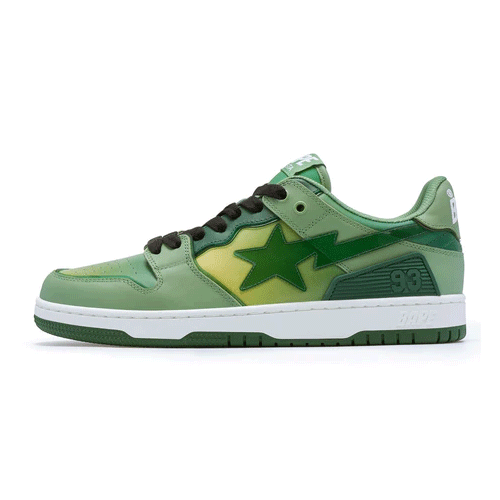
In the world of streetwear, few sneakers have made as bold a statement as the Bapesta. Known for its star-studded design and unapologetic flair, the Bapesta isn’t just a sneaker—it’s a symbol of rebellion, self-expression, and deep cultural influence. Whether you’re new to sneaker culture or a long-time collector, understanding the Bapesta’s journey from niche streetwear to global phenomenon is essential.
What is Bapesta?
The Bapesta is a sneaker designed and released by A Bathing Ape (BAPE), a Japanese streetwear brand founded by Nigo in 1993. Launched in the early 2000s, the Bapesta instantly turned heads for its striking resemblance to the Nike Air Force 1. But instead of being dismissed as a copycat, it was celebrated for its loud designs, patent leather colorways, and bold branding that spoke directly to hip-hop and youth subcultures.
From Tokyo to New York, the Bapesta became a fashion statement that said, “I know what’s up.” It was flashy without being tacky, luxurious yet street-ready. Its appeal wasn’t just in its aesthetics—it was in its attitude.
Origins and Influence
The early 2000s were a turning point in streetwear. Hip-hop was becoming mainstream, and artists were beginning to dictate fashion trends more than traditional designers. In this environment, the Bapesta found fertile ground. Nigo, already influential in Japan, was friends with Pharrell Williams, Kanye West, and other tastemakers who proudly rocked Bapestas during concerts, red carpets, and magazine shoots.
This co-sign from hip-hop royalty transformed the Bapesta into more than a Japanese curiosity—it became a global staple. From Lil Wayne to Soulja Boy, Bapestas were the footwear of choice for those who wanted to stand out, push boundaries, and celebrate individuality.
Design Language: More Than Just a Sneaker
Visually, the Bapesta draws heavily from the Air Force 1, but its branding is unmistakably unique. The signature shooting star logo, dubbed the “STA,” replaces Nike’s Swoosh, and the sneakers often come in patent leather with candy-colored hues. Limited edition designs often feature collaborations with pop culture icons, anime characters, and high-fashion designers, creating hype drops that sell out instantly.
What sets Bapesta apart isn’t just its silhouette. It’s the unapologetic use of vibrant colors, playful graphics, and bold materials. From camouflage prints to glossy metallic finishes, the design language screams confidence. It’s a shoe that dares to be different—and wins.
Collaborations and Limited Editions
One of the key strategies behind Bapesta’s sustained relevance is its approach to collaborations. Over the years, BAPE has teamed up with artists like Kanye West (who released the iconic “College Dropout” Bapesta), brands like Marvel and Adidas, and even franchises like Pokémon and Dragon Ball Z.
These collaborations blur the lines between fashion, music, and pop culture, making each Bapesta release a collectible. Sneakerheads don’t just buy Bapestas to wear—they buy them to own a piece of cultural history.
In today’s resale-driven sneaker economy, rare Bapesta drops can fetch thousands of dollars. Collectors scour the internet for vintage pairs, while new releases continue to create buzz across social media platforms.
Cultural Impact: Streetwear Meets Luxury
Bapesta has played a pivotal role in shifting streetwear from the underground to the forefront of luxury fashion. Long before brands like Off-White or Fear of God were partnering with high-end designers, BAPE was already bridging that gap. Its influence is visible in everything from sneaker design to celebrity fashion trends.
In fact, the term “hypebeast”—now widely used to describe streetwear-obsessed fashion fans—was popularized through BAPE’s core audience. Wearing a pair of Bapestas became shorthand for being in the know, being on trend, and being part of a global fashion tribe.
Today, BAPE stores in cities like Tokyo, New York, and London are pilgrimage sites for fans. The brand has managed to stay relevant not by chasing trends but by setting them—often years in advance.
Bapesta in 2025: The Legacy Continues
Fast forward to 2025, and Bapesta is more relevant than ever. New generations are discovering the silhouette through TikTok, Instagram, and YouTube sneaker reviews. Fashion influencers are pairing Bapestas with modern streetwear staples like oversized cargos, cropped bomber jackets, and minimalist techwear.
The sneaker has also seen a resurgence in high fashion circles. With the ongoing popularity of maximalism and nostalgia-driven design, the loud and proud aesthetic of the Bapesta fits perfectly into today’s fashion zeitgeist. Collaborations are still going strong, often selling out within minutes and creating instant resale value.
For collectors, vintage Bapestas are highly sought after. For newcomers, entry-level models offer an accessible way to get into the sneaker game with something that’s stylish, statement-making, and full of cultural meaning.
Styling the Bapesta: Then and Now
In the 2000s, Bapestas were often worn with baggy jeans, oversized tees, and trucker hats—a look heavily influenced by the hip-hop scene of the era. Pharrell, in particular, defined the early Bapesta style with his fusion of skate culture, high fashion, and hip-hop aesthetics.
In contrast, today’s styling leans more eclectic. Some wear them with tailored trousers and boxy blazers for a high-low look. Others keep it traditional with classic streetwear fits. Either way, the Bapesta remains versatile enough to complement a range of personal styles.
Whether you’re dressing for a sneaker convention, a casual day out, or a fashion-forward photoshoot, the Bapesta adapts—and always stands out.
Why the Bapesta Still Matters
At its core, the Bapesta matters because it represents more than just footwear. It’s about identity. It’s about self-expression. And it’s about owning a piece of history that continues to shape the future.
The sneaker world is crowded, competitive, and constantly evolving. Yet, amid all the noise, the Bapesta stands firm—an enduring icon that refuses to be forgotten. Whether you love it for its bold look, its musical associations, or its legacy in streetwear, there’s no denying that the Bapesta is here to stay.
Final Thoughts
For sneakerheads, fashion enthusiasts, and anyone who values culture-driven design, the Bapesta is more than just a shoe—it’s a movement. With its rich history, vibrant design language, and continued evolution, it represents the best of what streetwear can offer: originality, artistry, and attitude.





